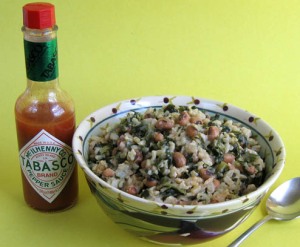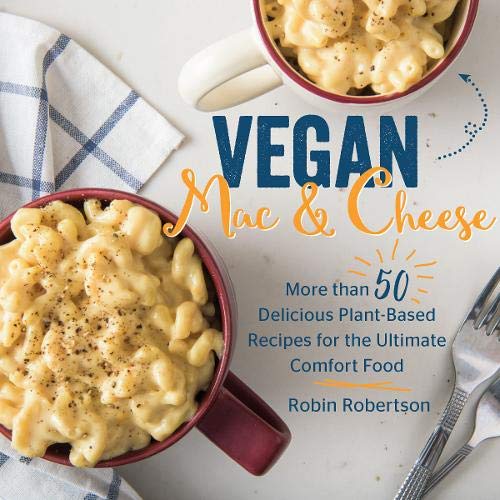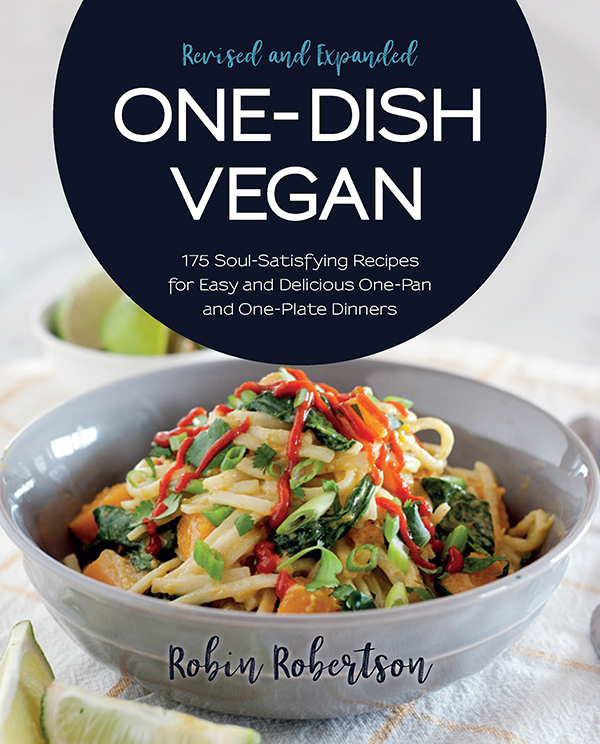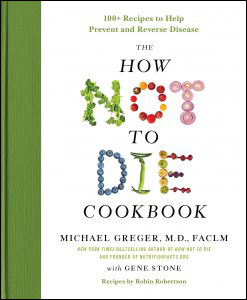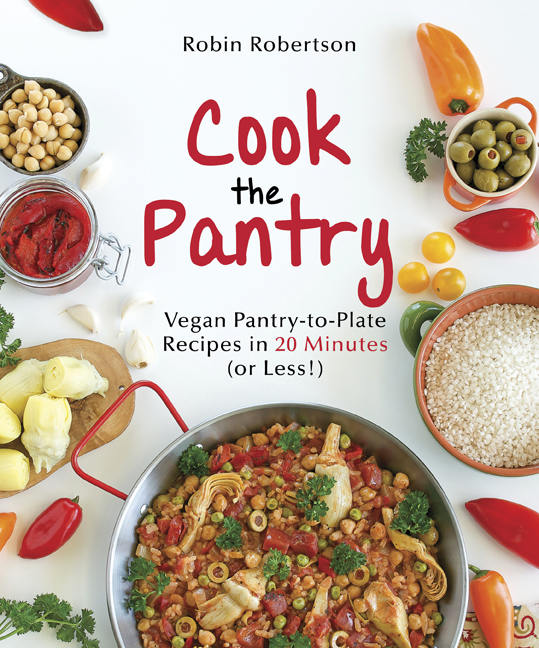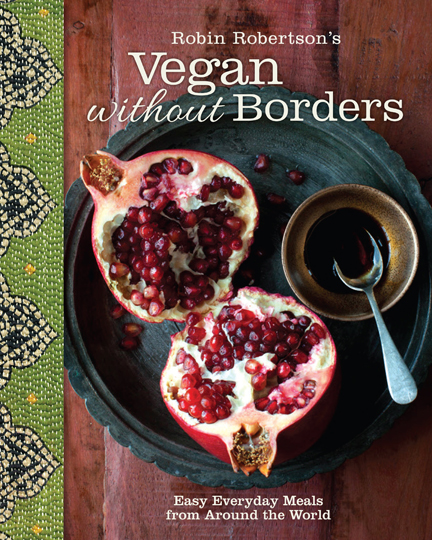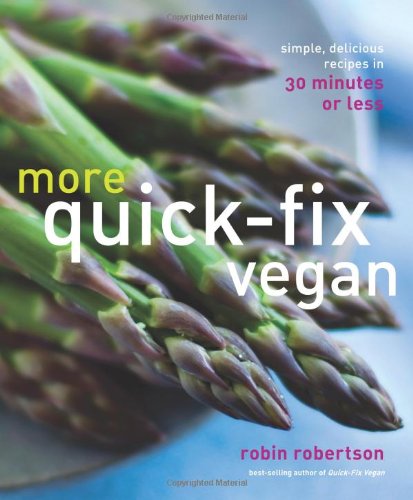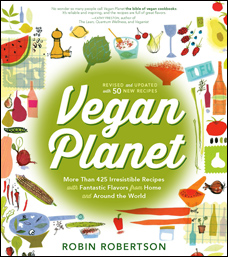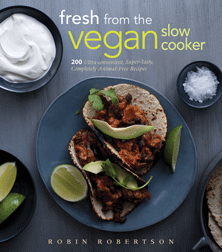After two years of hard work, I’m thrilled that my new cookbook, 1,000 Vegan Recipes is finally in the capable hands of my publisher. It comes out later this year — I don’t know the publication date yet, but I’ll keep you posted. Containing 1,000 recipes, this book will be nothing less than a historic event — the largest collection of vegan recipes ever in one volume!
Sometimes, I cook the black-eyed peas from scratch and use fresh collards. Other times, when I’m too busy to cook, I make a quick version using canned black-eyed peas and frozen chopped collards. Either way, it makes a satisfying dinner and the leftovers are even better the next day.
The collard greens are traditionally served on the side, but I like to cook them, chop them, and stir them right into the Hoppin’ John. A splash of Liquid Smoke adds a nice smoky nuance. I serve my Hoppin’ John in bowls with the vegan sour cream and a bottle of Tabasco at the table so you can add as much of either or both as you like.
Here’s my quick and easy version for you to try — but don’t wait until next New Year’s Day. It’s good enough to eat any day of the year.
Hoppin’ John with Collards
Use fresh or frozen collard greens for this recipe. If unavailable, substitute kale or other dark greens.
1 sweet yellow onion, chopped
1 cup long-grain brown rice
2 cups water or vegetable broth
Salt
3 cups cooked or 2 (16-ounce) cans black-eyed peas
3 cups chopped cooked collard greens
1 teaspoon Liquid Smoke
1/4 teaspoon freshly ground black pepper
Vegan sour cream, to serve
Tabasco sauce, to serve
2. About 15 minutes into the cooking of the rice, stir in the black-eyed peas.
3. When the rice is cooked, stir in the cooked chopped collards, Liquid Smoke, and black pepper. Add more salt, if needed.
4. To serve, spoon into bowls and accompany with vegan sour cream and Tabasco sauce at the table.
Serves 4

Although my tastes generally run to foods that are hot and spicy, caramelized, pan-seared, or grilled, sometimes I’m in the mood for simpler fare, especially on cold wintry days. This kind of weather often turns my thoughts to the cozy goodness of slow-cooker recipes. The other day I wanted something loaded with veggies but more substantial than soup. I cracked open a copy of Fresh from the Vegetarian Slow Cooker, and my eyes landed on the perfect solution: Pot au Feu!
Similar to the Italian bolito misto or the Boston boiled dinner my mother occasionally made when I was growing up, the pot au feu is simple no-frills comfort food. Literally pot on the fire, it refers to a French dish of meat and vegetables slowly cooked in water or broth. Usually, the rich broth is served with croutons as a first course.
The vegetables included may vary according to the region, but usually contain potatoes, carrots, and leeks. I added slices of seitan during the last thirty minutes of cooking time, just long enough to heat the seitan and let the rich flavors of the broth permeate it. Served with a crusty baguette and a glass of wine, it was just like dining in the French countryside — only different.
Slow Cooker Pot au Feu
This recipe is adapted from Fresh from the Vegetarian Slow Cooker. If you don’t have a large slow cooker, cut down on the quantities slightly so that everything fits. Instead of making a horseradish sauce as an accompaniment like I do in the book, I put out small bowls of prepared horseradish and coarse brown mustard. Of course, it’s best served with a baguette — try it sliced and toasted, then brushed with a little olive oil and rubbed with garlic.
2 leeks, white part only, halved lengthwise and well washed
1 pound small red potatoes, halved
2 parsnips, peeled and sliced
2 small turnips, peeled and quartered
1 1/2 cups baby carrots
1 celery rib, cut into 2-inch pieces
1 small head Savoy cabbage, cut into 6 wedges
4 cups vegetable broth
1 bouquet garni (cheesecloth bundle containing peppercorns, cloves, cinnamon stick thyme, parsley, and bay leaves)
Splash of dry white wine
Salt and freshly ground black pepper
8 ounces seitan, thinly sliced
1. Cut the leeks into 3-inch long pieces and place them in a 5 1/2 to 6-quart slow cooker. Add the potatoes, parsnips, turnips, carrots, celery, and cabbage. Pour the broth over all, add the bouquet garni and a splash of wine. Season with salt and pepper to taste. The amount of salt needed depends on the saltiness of your broth. Cover and cook on Low for 6 to 7 hours, or until vegetables are tender. (See note.)
2. During the last 30 minutes of cooking, add the seitan slices. Taste the broth and adjust the seasonings, if needed.
3. To serve, remove vegetables and seitan from the broth. Discard the bouquet garni. Serve the broth as a first course or alongside the entrée. Arrange the vegetables and seitan on a large platter. Serve with condiments and toasted bread.
Serves 4
Note: Some slow cookers (crockpots) cook faster than others. The cooking time is approximate. If you want your meal cooked faster, cook it on High and it should be ready in about 4 hours. In either case, if possible, after about 3 hours, pierce your vegetables with a fork to test for doneness, and baste with some of the broth.

When I asked my friend Patty, a native of Buenos Aires, to tell me about her favorite foods growing up, I expected to hear about all kinds of exotic South American fare. Instead, she told me her favorite meal was pasta with marinara sauce. She explained that Italian food is popular there because of the Italian immigrants who settled in Argentina in the late 1800s. Argentine cuisine varies further due to the influences of other European settlers, such as the Spanish and British, along with the native Indians.
Patty also told me about a popular spicy lemon-marinated beef dish, for which I mentally substituted “seitan” for the beef and quickly set about to making my adaptation a reality. The tangy lemon flavor permeates the seitan which is then dredged in seasoned breadcrumbs and pan-fried or broiled until crisp and brown. It turned out so well that I included the recipe in Vegan Fire and Spice.
When I made it recently, I served it with sides of sautéed red chard and potatoes sautéed with red onion, red pepper flakes, oregano, and lemon juice, which complemented the seitan nicely.
In the book, the seitan for this recipe is broiled (with sautéing or grilling optional). Here’s the recipe the way I made it the other night, pan-fried:
Argentinean-Inspired Seitan Cutlets
This recipe is adapted from Vegan Fire and Spice.
1/4 cup fresh lemon juice
1/2 plus 1/4 teaspoon hot red pepper flakes
1/2 teaspoon salt, divided
4 tablespoons olive oil, divided
8 ounces seitan, cut into 1/4-inch cutlets
1 cup dried bread crumbs
1/2 teaspoon dried oregano
Lemon wedges, for garnish
1. For the marinade, combine the lemon juice, 1/2 teaspoon hot red pepper flakes, 1/4 teaspoon salt, and 2 tablespoons of olive oil in a bowl. Arrange the seitan cutlets in a baking dish without overlapping and pour the marinade over them. Marinate for 1/2 hour at room temperature, or several hours in the refrigerator, turning once or twice to spread the seasoning mixture evenly.
2. Place the breadcrumbs in a shallow bowl. Add the remaining 1/4 teaspoon red pepper flakes, 1/4 teaspoon salt, and the oregano. Remove the seitan from the marinade and dredge in the bread crumbs, pressing the crumbs into the cutlets with your hands.
3. Heat the remaining oil in a large skillet over medium heat. Add the cutlets, in batches if necessary, and cook until crisp and golden brown on both sides, turning once, 3 to 4 minutes per side. Serve with lemon wedges.
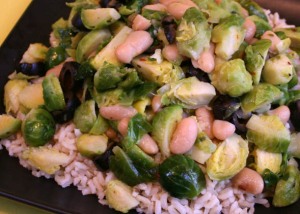
I love the challenge of making a decent meal when there’s almost nothing in the cupboard and fridge. I was put to the test last night. I’ve been cooking like crazy lately, testing recipes for my fall 2009 book, 1,000 Vegan Recipes, and buying only the groceries I needed for each batch of testing. The previous day, I had tested the final recipe I had shopped for and just didn’t feel like going grocery shopping for another round. After spending the day at my computer yesterday, I was oblivious to the fact that the refrigerator and pantry were nearly empty. Then suddenly it was time for dinner. Fortunately, some lonely brown rice and canned beans were among the few remaining items in the pantry — a good start. But what about vegetables?
Even when I have a full larder, I often look to vegetables to inspire a meal, but the only vegetable I had in the house was a bag of frozen baby Brussels sprouts. I usually like to roast Brussels sprouts in a hot oven and spritz them with lemon juice. But for this meal, I decided to cook the tiny orbs the way I would broccoli rabe or escarole. After a quick blanching, I sliced them and sautéed them in garlic and olive oil until tender, sprinkled with basil, oregano, salt and pepper, and hot red pepper flakes. I then added capers, black olives, and cannellini beans and sautéed everything until hot. Served on a bed of brown rice, it turned out to be a satisfying and flavorful meal. Of course, now the cupboard REALLY is bare!
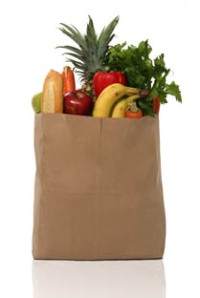
The response to my call for recipe testers has been overwhelming and I thank you all for your enthusiasm and desire to help. With so many talented cooks willing and able to sign on, I definitely now have enough testers lined up for the next few books! Thanks again for your interest and for all the kind words about my work.


